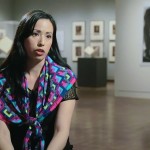by Alejandra Padín-Dujon
When asked about his affinity for incorporating office supplies into installations, Christopher Cozier grins and says, “there’s something mischievous about […] using the arsenal of bureaucracy for critique.” He quickly adds that his brand of “mischief” differs from the doctrinal radicalism of his peers.
On October 8th the acclaimed Trinidadian artist, writer, and curator addressed a modest crowd of mostly graduate students in the basement of the Loria Center. His hour-long speech is an earnest primer on the art and philosophy of an inquisitive man.
As a Caribbean exploring post-colonial society through his craft, Cozier walks an oddly charged line between the apolitical and the militant.
His perspective on art and politics is more exploratory than ideological—this much is clear even in his demeanor, from the way he presents ideas in broad sketches to the way he speaks with a gentle lilt and prefaces all descriptions with a modest “kind of.” Cozier’s most strong-willed trait is a stubborn defiance of classification; his ethos, a commitment to surveying society in playful good faith.
What is his medium? It’s hard to say. Since his first travels to the United States from Trinidad nearly 30 years ago to attend design school, he has experimented with painting, drawing, film, and a wide variety of installations.
Cozier is the exceptional professional who remains in Trinidad, yet his existence is hardly provincial: love of country meets a cosmopolitan lifestyle that includes awards and exhibitions in far-flung Johannesburg, Amsterdam, Port-au-Prince, and Chicago.
He ventures with genuine zest into the sociopolitical.
He once hung 400 yellow rulers from the buttress of a Danish church in reference to the Peter Tosh song “400 Years.” (Peter Tosh was an influential Jamaican reggae musician—to Bob Marley as Malcolm X was to MLK.
One of his best known works is a grid of hundreds of identically-wrapped, flag-topped sandwiches entitled “Attack of the Sandwich Men,” meant to question the conflation of modernity with organized conformity in his post-colonial world. He also collaborates with Caribbean-American janitors and films men in suits swinging nozzles—his two cents on Trinidad’s oil economy.
Yet he rejects the label of “Caribbean artist” out of hand because it is too reductive.
Cozier insists on being known as an individual exploring facets his own experience rather than as a tokenized public advocate for every dimension of his Trinidadian identity. He protests that he is neither a mouthpiece for Trinidad, nor a self-appointed authority on the Caribbean, or the Third World, or the African Diaspora.
Therein lies the crucial paradox. It is political for him to make sociopolitical structures incidental to portrayals of humanity, and not the other way around.
Universities love politicization and radicalism. From extremes come critical thinking, openness, and education—or so the logic goes. In such an environment, it is a breath of fresh air to hear the words of one who has chosen a distinct but more self-aware path, and such is the power of Christopher Cozier: artist and social interpreter extraordinaire.


